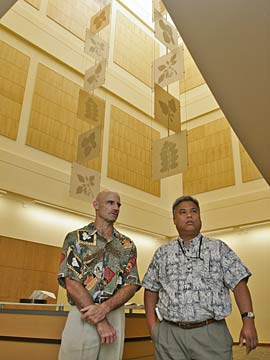
|
State-of-art biomedical
campus complete
Focus shifts now to
the big job of moving
sensitive research
Construction is over at the John A. Burns School of Medicine's bioresearch building, where Hawaiian healing traditions blend with the latest technology.
Hawaiian medicinal plants are growing in a garden in the front yard. Hawaiian plants also appear in a decorative band cast in the concrete walls outside, in an inside atrium and in a stunning mobile in the lobby of the four-story bioresearch building.
Education amenities include a video teleconference room, virtual reality technology for medical and surgical simulations, a 150-seat auditorium equipped for real-time videoconferencing and a health science library open around the clock.
While the University of Hawaii officially takes over the 180,000-square-foot building today, dedication ceremonies will be held Sept. 30.
When people visit the facility, "their jaws drop," Dr. Samuel Shomaker, acting medical school dean, said during a tour this week. "It is pretty spectacular."
Students began attending classes at the 10-acre medical school complex in April, when the education building was completed.
Workers are finishing odds and ends on the research facility, but the big job ahead belongs to movers.
"It's not an everyday thing," pointed out Francis Blanco, director of project planning and facilities. "It's a huge logistical enterprise, coordinating and minimizing downtime in the labs."

Francis Blanco, director of facilities, shows the morgue room of the new University of Hawaii medical school, where cadavers awaiting study will be stored on body racks.
All equipment and specimens must be documented and cataloged for transport from the UH-Manoa campus, and freezers and incubators must be ready for them at Kakaako, he said.
Frequent meetings are held to go over the move, with UH environmental health and safety people participating, Blanco said.
"The operation side is critical, too," he said. "We're tweaking out the building" to make sure it is maintained and operating without a glitch, he said. Staff training is going on for the building systems and air conditioning.
About 200 people are expected to occupy the new research building, including 36 principal investigators and their teams, Shomaker said.
Blanco said they probably cannot begin work in their new quarters until late October, after "a lot of staging and phasing," starting with equipment, then specimens. Some labs could be down a couple of weeks, he said.
Relocation of scientific equipment worth hundreds of thousands of dollars requires "pretty careful dismantling and reassembling," Shomaker said.
A sign in front of the new medical school says the goal was "to design and build an inspired, globally competitive biomedical research and educational campus."
"It's really beautiful, better than expected," Shomaker said. "I would have liked to have gone to medical school here."
He attended classes in the old biomedical building on the Manoa campus, graduating in 1986, he said. That building has been under renovation since the October flood, and some medical school programs will remain there.
Blanco said most people are amazed at the space in the new medical school, coupled with the most advanced equipment. It has great flexibility, he said. "It can accommodate any work a researcher has."
It is a vast improvement for students as well as faculty, Shomaker said.
A gross anatomy lab, for example, will accommodate 62 students at a time, with surgical lamps, a computer and other technical tools at each station and lots of room for faculty and student interaction, he said.
Laboratories will be equipped with a lot of expensive equipment, biosafety cabinets, tissue incubators and freezers, Blanco said.
Security is tight throughout the research floors, with only biometric access (using thumb prints) to certain areas.
Sea water is pumped from two wells to chill the building, Blanco said, and oxygen and carbon dioxide are supplied directly to the lab stations. Standby emergency power will be provided to all core areas.
The medical school's research enterprise is envisioned as stimulating a life sciences industry for Hawaii, with economic biotech spinoffs.
Shomaker believes UH can be "world class" in such areas as infectious disease, tropical medicine, neuroscience and reproduction, as well as development, cell and molecular biology.
"It depends who we recruit, and developments the existing faculty participate in," he said. "We have hired really great people, and we have a world-class facility."
UH medical schoolSome background on the University of Hawaii John A. Burns School of Medicine:» It began in 1967 as a two-year program of basic medical sciences, and became a four-year program awarding degrees in 1973. » It had awarded 1,802 medical degrees as of June, including 184 to native Hawaiians. » About half of the state's practicing doctors are graduates of the UH medical or residency programs. » The school was floundering financially and threatened with closure when Dr. Edwin Cadman, former Yale University professor of medicine, was hired as dean in mid-1999. » The school was revitalized, and funding grew to about $113 million in 2004-2005, including $53 million in grants and contracts. » The 2001 Legislature authorized $150 million in bonds from tobacco settlement money to finance a new 10-acre medical school at Kakaako. » Students began classes in the 140,000-square-foot education building in April. Contractors turn the 180,000-square-foot research building over to the school today. » Cadman resigned as dean in June because of illness but continues to assist at the school, teaching first-year students. » His vision of the school as an "economic engine" for the state is continuing as the school develops partnerships with biotechnology companies on the mainland and in Asia.
Source: John A. Burns School of Medicine
|
hawaiimed.hawaii.edu
E-mail to City Desk
[News] [Business] [Features] [Sports] [Editorial] [Do It Electric!]
[Classified Ads] [Search] [Subscribe] [Info] [Letter to Editor]
[Feedback]
